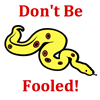
|
Charge Interactions
Charged objects show a noticeable interaction with other surrounding objects. The cause of the interaction can be summarized by one of the following three statements:
- Oppositely charged objects attract each other.
- Like-charged objects repel each other.
- Any charged object - whether positive or negative - will attract a neutral object.
|

|
Both balloon Y and balloon Z attract balloon X - an object of known charge. The three different types of charge interactions are discussed in the Know the Lawsection. Observe that there are two ways by which two objects can attract. So knowing the charge on balloon X allows you to be somewhat conclusive about the type of charge on balloons Y and Z.
|

|
When reviewing the three different types of charge interactions (see Know the Law section), you will notice that two of the interaction types involve an attraction of two objects. Oppositely charged objects indeed attract. But that is not the only cause for two objects attracting each other. A charged object and a neutral object will also attract. So knowing that two objects attract each other is NOT sufficient evidence to conclude that both objects are charged. Don't be fooled! If two objects attract, then it is possible that one object is charged and the other is electrically neutral.
|